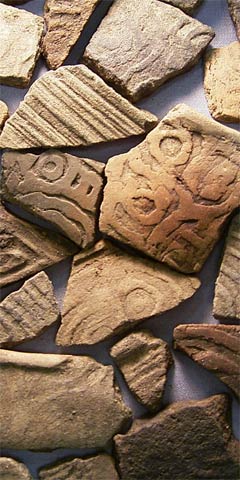- Home page
- What were you doing out there on Highway 61?
- Why did you dig there?
- Where is the site?
- Who lived there?
- What happens after the digging?
- What is archaeology?
- What is it like to work on a field crew?
- What is it like to work in the lab?
- Are there laws that protect archaeological sites?
- Ask a Native American about tribal history, archaeology, and more
- Who can I contact for more information?
- Special pages for students
- Special pages for teachers
- Special pages for archaeologists
Answering your questions
‘Who lived here?’
The Leake Site occupants left no tradition of who they were or by what name they were called. All we know of these people comes from archaeological studies conducted here in the Etowah Valley and at other sites from the same period located throughout the eastern United States. Native Americans have been in the Etowah River Valley since at least the end of the last ice age, about 14,000 years ago. Radio-carbon dates from previous work on the Leake Site range from about 100 BC to AD 400 or during what archaeologists call the Middle Woodland Period. We know that the people hunted, fished, and gathered wild and domesticated vegetable crops. That there were two earthen mounds on the site tells us that a powerful chief and successors lived here for several centuries. The site was situated within a major trade corridor running north - south from the Gulf Coast to the Great Lakes. Power and influence may have been enhanced by the strategic location of the Leake Site.
Archaeologists who have studied the Middle Woodland Period recognize certain cultural traits that are shared by different native societies across a wide area of the southeastern U.S. during this time. Perhaps the most distinctive shared trait is the decorated pottery vessels made by the potters of the time. Before the clay bowls and jars were fired, the wet surface was impressed with a carved wooden paddle. The designs on the paddles were intricate combinations of geometric elements that archaeologists have termed Swift Creek Complicated Stamped after the name of the middle Georgia stream where such pottery was first recognized. This is one of the most distinctive Native American decorative styles and provides a durable example of the extraordinary skills of the wood carvers and potters. Swift Creek Complicated Stamped pottery designs give us a look into the artistic expression and symbolism of a long dead culture.
For additional information, The Georgia Encyclopedia (a great resource for information about our state) provides an overview of the Woodland and an overview of the Swift Creek culture.
